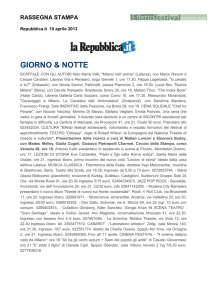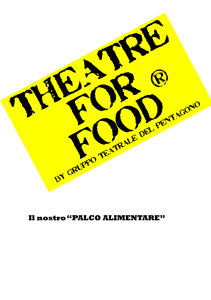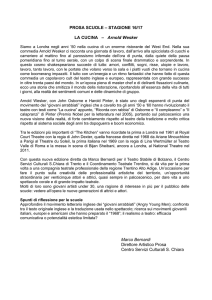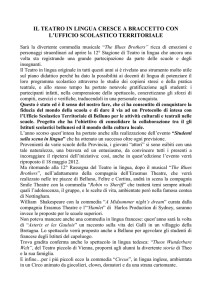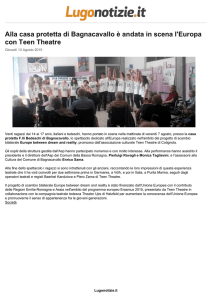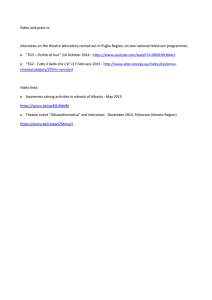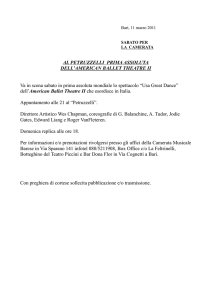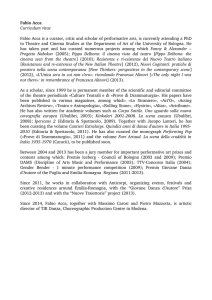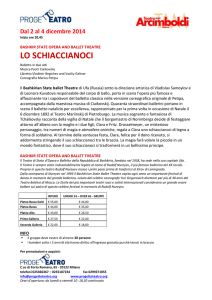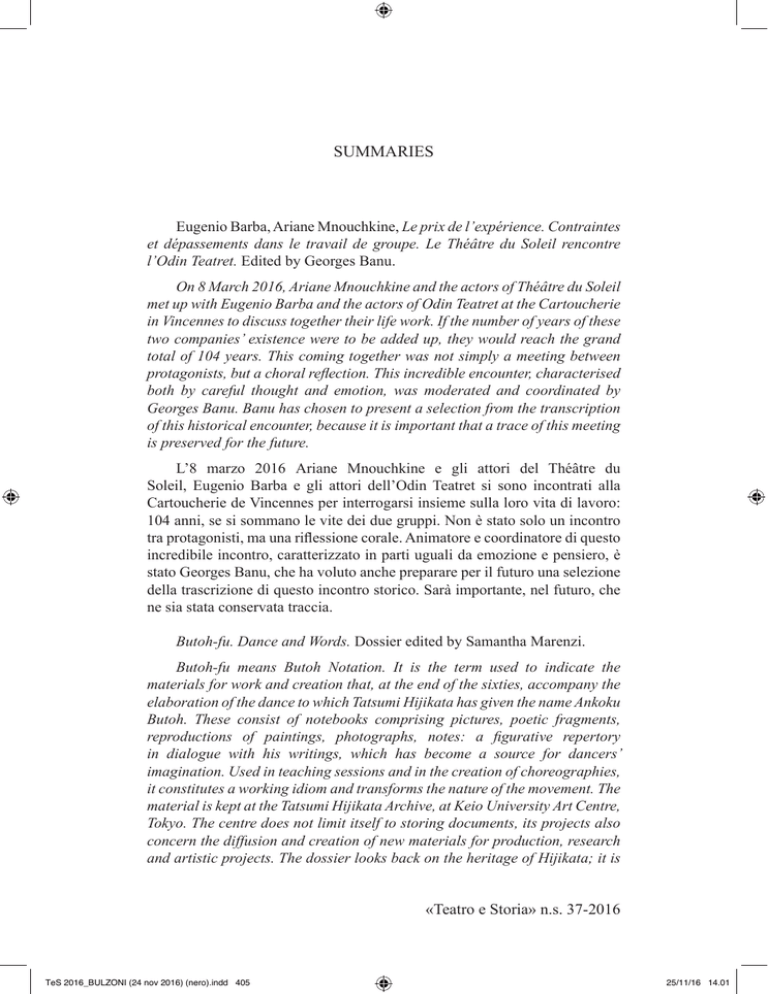
SUMMARIES
Eugenio Barba, Ariane Mnouchkine, Le prix de l’expérience. Contraintes
et dépassements dans le travail de groupe. Le Théâtre du Soleil rencontre
l’Odin Teatret. Edited by Georges Banu.
On 8 March 2016, Ariane Mnouchkine and the actors of Théâtre du Soleil
met up with Eugenio Barba and the actors of Odin Teatret at the Cartoucherie
in Vincennes to discuss together their life work. If the number of years of these
two companies’ existence were to be added up, they would reach the grand
total of 104 years. This coming together was not simply a meeting between
protagonists, but a choral reflection. This incredible encounter, characterised
both by careful thought and emotion, was moderated and coordinated by
Georges Banu. Banu has chosen to present a selection from the transcription
of this historical encounter, because it is important that a trace of this meeting
is preserved for the future.
L’8 marzo 2016 Ariane Mnouchkine e gli attori del Théâtre du
Soleil, Eugenio Barba e gli attori dell’Odin Teatret si sono incontrati alla
Cartoucherie de Vincennes per interrogarsi insieme sulla loro vita di lavoro:
104 anni, se si sommano le vite dei due gruppi. Non è stato solo un incontro
tra protagonisti, ma una riflessione corale. Animatore e coordinatore di questo
incredibile incontro, caratterizzato in parti uguali da emozione e pensiero, è
stato Georges Banu, che ha voluto anche preparare per il futuro una selezione
della trascrizione di questo incontro storico. Sarà importante, nel futuro, che
ne sia stata conservata traccia.
Butoh-fu. Dance and Words. Dossier edited by Samantha Marenzi.
Butoh-fu means Butoh Notation. It is the term used to indicate the
materials for work and creation that, at the end of the sixties, accompany the
elaboration of the dance to which Tatsumi Hijikata has given the name Ankoku
Butoh. These consist of notebooks comprising pictures, poetic fragments,
reproductions of paintings, photographs, notes: a figurative repertory
in dialogue with his writings, which has become a source for dancers’
imagination. Used in teaching sessions and in the creation of choreographies,
it constitutes a working idiom and transforms the nature of the movement. The
material is kept at the Tatsumi Hijikata Archive, at Keio University Art Centre,
Tokyo. The centre does not limit itself to storing documents, its projects also
concern the diffusion and creation of new materials for production, research
and artistic projects. The dossier looks back on the heritage of Hijikata; it is
«Teatro e Storia» n.s. 37-2016
TeS 2016_BULZONI (24 nov 2016) (nero).indd 405
25/11/16 14.01
406
SUMMARIES
dedicated to the connections between dance and writing, between archives
and the transmission of performative experiences, between body and word.
It includes contributions of scholars such as Bruce Baird, Stephen Barber,
Katja Centonze, Maria Pia D’Orazi, Takashi Morishita – the director of the
Tatsumi Hijikata Archive, and the dancer Akira Kasai.
Butoh-fu significa Butoh Notation. È il termine usato per indicare i
materiali di lavoro e creazione che affiancano, dalla fine degli anni Sessanta,
l’elaborazione della danza a cui Tatsumi Hijikata ha dato il nome di Ankoku
Butoh. Sono quaderni che raccolgono immagini, frammenti poetici,
riproduzioni di quadri, fotografie, appunti: un repertorio figurativo che dialoga
con la scrittura, e diventa una sorgente per l’immaginazione dei danzatori.
Utilizzato nelle sessioni pedagogiche e nella creazione delle coreografe,
costituisce una lingua di lavoro e trasforma la natura del movimento. Il
materiale è conservato nel Tatsumi Hijikata Archive, al Keio University Art
Centre di Tokyo, impegnato in progetti non solo di conservazione, ma di
diffusione e creazione di nuovi materiali, di produzione di ricerche e progetti
artistici. Guardando all’eredità di Hijikata, il dossier è dedicato al rapporto
tra danza e scrittura, tra archivi e trasmissione delle esperienze performative,
tra corpo e parola. Ospita i contributi degli studiosi Bruce Baird, Stephen
Barber, Katja Centonze, Maria Pia D’Orazi, del direttore del Tatsumi Hijikata
Archive, Takashi Morishita, e del danzatore Akira Kasai.
Raimondo Guarino, Shakespeare: collective mind and minor traditions.
The notion of influence in Shakespeare’s theatre (and its action) should
be tackled and its scope enlarged beyond the so-called intertextuality and
materiality of texts, to penetrate the peculiar interplay of written traditions
and oral acting skills in the London public playhouses. Taking as a starting
point some relevant premises and assumptions in Shakespearean studies (the
notion of recollection; the distinction between memorising and remembering
within the repertory), the article focuses on the transactions between speech
and writing, between literary values and performance practices. It focuses in
particular on three topics: declamation and composition around 1590; a short
intermezzo about the poets’ war and the definition of literary identities around
1600; some considerations on Shakespeare’s collaboration with Fletcher for
The Two Noble Kinsmen.
È opportuno rimettere in discussione la nozione (e l’azione) delle
influenze nel teatro shakespeariano e allargarla, andando oltre la cosiddetta
intertestualità e la materialità dei testi, al peculiare intreccio di tradizioni
scritte e tecniche orali della recitazione dei teatri pubblici di Londra. A partire
da alcune premesse e congetture rilevanti presenti negli studi (la nozione di
TeS 2016_BULZONI (24 nov 2016) (nero).indd 406
25/11/16 14.01
SUMMARIES
407
memoria; la distinzione tra memorizzare e ricordare nel repertorio), il saggio
si concentra sulle transazioni tra la parola e lo scritto, tra i valori letterari
e le pratiche performative, puntando l’attenzione su tre temi in particolare:
declamazione e composizione intorno al 1590; guerra dei poeti e definizione
di identità letterarie intorno al 1600; collaborazione fra Shakespeare e Fletcher
per The Two Noble Kinsmen.
Franco Ruffini, Meyerhold, Biomechanics, varieties of Biomechanics.
Pedagogy, science, revolution. Meyerhold’s biomechanics flows across
all these territories like a huge river; it penetrates them to the point where
it practically uses only their words to express itself. Franco Ruffini’s article
does not deal with pedagogy, science or revolution. The author wonders what
underlying aspects of biomechanics are in danger of being forgotten. Its origin:
the marionette and the puppeteer Giovanni Grasso. For Meyerhold and his
biomechanics, this was not simply a starting point, rather it was a source of
energy. Other varieties of ‘biomechanics’ – such as Craig’s or Stanislavsky’s –
derive their energy from their source; from the point where, before becoming
territories that may be traversed, they lay claim to the dignity of the body. Not
only that of the actor on the stage.
Pedagogia, scienze, rivoluzione. Come un grande fiume, la biomeccanica
di Mejerchol’d attraversa tutti questi territori, e se ne intride fin quasi
a farsi parlare solo con le loro parole. Il saggio di Franco Ruffini non
tratta di pedagogia, scienze e rivoluzione. S’interroga su quello che della
biomeccanica rischia di finire scordato al di sotto. La sua origine: nella
marionetta e nell’attore puparo Giovanni Grasso. Ben più che punto d’inizio,
per Mejerchol’d e la sua biomeccanica l’origine fu soprattutto una sorgente
di forza. Le “biomeccaniche” – quella di Craig o di Stanislavskij – prendono
forza proprio dall’origine: dove la biomeccanica, prima d’essere i territori
destinata ad attraversare, era una rivendicazione di dignità del corpo. Non
solo dell’attore in scena.
Beppe Chierichetti, A little before Ista. Letter to Renzo Vescovi.
Our director, Renzo Vescovi, died suddenly on a Sunday, (in the space of
a few hours. What has happened before that there was a space of a few hours).
At his death, we all felt that we were at the edge of a precipice. The only
thing that saved us was our work: we had to give a performance near Trieste
a few days later. As well we had a festival to prepare for twenty days from
then. When a performance has to be given, it has to be given. Nothing can
upset those plans. We had to deal with the banks, the marketing, the artistic
aspect. But most of all, we had to deal with a much bigger problem: what
TeS 2016_BULZONI (24 nov 2016) (nero).indd 407
25/11/16 14.01
408
SUMMARIES
was the point for a group, built around a leader-director, to continue to exist
after his death? We pushed on day by day, without seeking a reply to this
terrible question. More than ten years have passed, and we are still alive. We
survived, without him. Thanks to him, and to all he had taught us. Thanks to
what we had given back to him, over the years. Thanks to what he gave back
to us in return, over the years. And to what we discovered we had when he
died, as though he had left us an inheritance which was buried deeply within
each of us.
Il nostro regista, Renzo Vescovi, è morto di domenica, all’improvviso,
in poche ore. Con la sua morte ci siamo trovati di fronte a un baratro. L’unica
cosa che ci ha salvati è stata la nostra attività: dovevamo fare uno spettacolo
vicino Trieste qualche giorno dopo. E avevamo un festival da preparare entro
20 giorni. Quando bisogna fare lo spettacolo, bisogna farlo. Non c’è nulla che
possa far cambiare i piani. Dovevamo affrontare il problema delle banche,
il problema del mercato, il problema artistico. Ma soprattutto dovevamo
affrontare un altro problema, più grande di tutti: che senso ha che un gruppo
costruito intorno a un regista-leader continui a vivere dopo la sua morte?
Abbiamo continuato a vivere giorno per giorno, senza cercare una risposta
a questa domanda terribile. Son passati più di dieci anni, siamo ancora vivi.
Siamo sopravvissuti, senza di lui. Grazie a lui, a quel che ci aveva insegnato.
A quel che gli abbiamo dato, in tanti anni. A quel che ci ha restituito, in tanti
anni. A quel che ci siamo scoperti in mano quando è morto, come se ci avesse
lasciato una eredità sepolta profondamente entro ognuno di noi.
Mirella Schino, Ista-the-Whale. Documents and thoughts on the
International School of Theatre Anthropology.
In the course of the twentieth century, theatre has sometimes forsaken its
tendentially solitary introverted nature. There have been moments and places
that have produced relationships that were not necessarily tangible. That
brought changes in mentality rather than transformations in theatre practice.
They produced no concrete result, but created networks of communication
and unexpected or invisible connections. Perhaps they were important –
even vital – moments of transition. Ista, the International School of Theatre
Anthropology, has been one of these places. But in order to dig deeper into
this less obvious and visible perspective, it is necessary to start to observe
it, by temporarily removing, in the metaphorical sense, the aspects which
have always been retained as central: the presence of Eugenio Barba, Odin,
theatre anthropology, personal memories.
Nel corso del Novecento, il teatro ha qualche volta abbandonato la sua
natura, tendenzialmente solitaria, chiusa in sé. Ci sono stati momenti e luoghi
TeS 2016_BULZONI (24 nov 2016) (nero).indd 408
25/11/16 14.01
SUMMARIES
409
che hanno prodotto relazioni, non necessariamente concrete. Cambiamenti
nella mentalità, più che trasformazioni nel teatro pratico. Non sono serviti a
niente di concreto, però hanno creato reti di comunicazioni e passaggi spesso
imprevedibili, o invisibili. Forse sono stati momenti di passaggio essenziali,
perfino vitali. Uno di questi luoghi è stato l’Ista, l’International School
of Theatre Anthropology. Ma per cercare di andare a fondo in questo suo
aspetto meno visibile e appariscente, è necessario cominciare a osservarla
rimuovendo, metaforicamente e temporaneamente, gli aspetti da sempre
ritenuti centrali: la presenza di Eugenio Barba, l’Odin, l’antropologia teatrale,
le memorie personali.
Ron Jenkins, The Overlapping Dialogues of Dario Fo. Letter on the
Tenth Ista.
The staff and participants of Ista have always arrived with the ghosts of
their teachers trailing behind them. I arrived with the spirits of Dario Fo and
Franca Rame, who taught me that Arlecchino and Colombina are immortal; I
Made Djimat, who introduced me to sacred laughter in Bali; Etienne Decroux,
who terrified me into appreciating the geometry of the human musculature;
and Lou Jacobs, who showed me that circus clowns are also acrobats of the
soul. These ghosts encountered the ghosts brought by other participants:
Meyerhold, Brecht, Sanjukta Panigrahi, Grotowski, Artaud, Mei Lan-Fan,
Stanislavski. Some of the ghosts were present in spirit. Others appeared in the
flesh. In 1996 Dario Fo was one of the guiding spirits of Ista who appeared
in person.
Lo staff e i partecipanti dell’Ista sono sempre arrivati con al seguito il
corteo dei fantasmi dei loro maestri. Io ci sono arrivato accompagnato dagli
spiriti di Dario Fo e Franca Rame che mi hanno insegnato che Arlecchino e
Colombina sono immortali, di I Made Djimat che mi ha fatto conoscere il
riso sacro di Bali, di Etienne Decroux che mi ha condotto ad apprezzare con
sbigottimento la geometria della muscolatura umana, e di Lou Jacobs che
mi ha mostrato che i clown del circo sono anche acrobati dell’anima, Questi
fantasmi hanno incontrato i fantasmi portati da altri partecipanti: Mejerchol’d,
Brecht, Sanjukta Panigrahi, Grotowski, Artaud, Mei Lan-Fan, Stanislavskij.
Alcuni fantasmi sono stati presenti in spirito. Altri sono apparsi in carne e
ossa. Nel 1996 Dario Fo fu uno degli spiriti guida dell’Ista apparsi di persona.
Ferdinando Taviani, Ista 1980. Letter on a School of War.
Almost forty years have passed since the first Ista session. The problem
of pedagogy, as it appears today, has little to do with what it seemed to be at
the end of the seventies, when Ista was thought up and given form. This is why
TeS 2016_BULZONI (24 nov 2016) (nero).indd 409
25/11/16 14.01
410
SUMMARIES
it is essential to go back to thinking about those years, which recently have
become once again a topic of discussion. What did ‘pedagogy’ mean in those
years?
Sono passati quasi quarant’anni dalla prima sessione dell’Ista. Il
problema della pedagogia così come ci appare ora ha ben poco a che fare
con quello che appariva alla fine degli anni Settanta, quando l’Ista è stata
immaginata e concretizzata. Per questo bisogna ritornare a riflettere su quegli
anni, di cui ultimamente si parla nuovamente molto. Che cosa significava
“pedagogia” in quegli anni?
Raffaella di Tizio, Vito Pandolfi’s catchpenny opera.
Teatro Argentina, 11 February 1943, the premiere of The Beggar’s
Opera, a personal version by the young director Vito Pandolfi, of Brecht’s
Threepenny Opera, which was prohibited in Italy at the time. This article
reflects on the meaning of Vito Pandolfi’s marginalisation within Italian postwar theatre. In The Beggar’s Opera, where he had managed to concentrate the
tensions that characterised the end of the fascist period, Pandolfi appeared to
be one of the most promising future protagonists of the theatre. When things
became stable once more, his theatre took a different turn.
Attraverso l’analisi di una sua esperienza giovanile – la regia de L’opera
dello straccione, personale versione dell’allora proibita Opera da tre soldi di
Bertolt Brecht andata in scena al Teatro Argentina l’11 febbraio del 1943 – il
saggio propone una riflessione sul senso della marginalità di Vito Pandolfi
all’interno del teatro italiano del dopoguerra. Con L’opera dello straccione,
in cui aveva saputo condensare le tensioni che animavano il periodo della fine
del regime fascista, Pandolfi era apparso come una delle maggiori promesse
per il teatro del futuro. Nel periodo della stabilità, la sua proposta teatrale
avrebbe avuto un’altra sorte.
Luca Vonella, The books underlying theatre. From Lectio Doctoralis by
Ludwik Flaszen.
Dear Mirella, on 10 October 2015, I went to listen to Ludwik Flaszen’s
Lectio Doctoralis in Turin. Perhaps I went there not only, to listen to a great
intellectual, Grotowski’s literary consultant, the director’s accomplice in his
radical visions, a man who is fully part of the history of twentieth-century
theatre. Perhaps I went there to look for something else. For a cutting
question, of the kind that are always stated with sarcasm – to understand
the distance between the cultural panorama of Socialist Poland from which
Flaszen’s story emerges, and the present, which in comparison seems so poor.
TeS 2016_BULZONI (24 nov 2016) (nero).indd 410
25/11/16 14.01
SUMMARIES
411
Cara Mirella, il 10 ottobre 2015 sono andato ad ascoltare la Lectio
Doctoralis di Ludwik Flaszen a Torino. Ci sono andato, forse, non solo per
ascoltare un grande intellettuale, il consulente letterario di Grotowski, il
complice delle sue visioni radicali, un uomo che rientra a pieno titolo nella
storia del teatro del Novecento. Forse ci sono andato anche per qualcos’altro.
Per un interrogativo tagliente, di quelli che si enunciano sempre con sarcasmo:
per capire quanta distanza c’è tra il panorama culturale della Polonia socialista
in cui si staglia la storia di Ludwik Flaszen e quello che a confronto mi sembra
un presente tanto misero.
The Economics and Business of Theatre. Dossier (comprising: Marco
Consolini, Italian theatre as seen from «Comœdia». Observations on the
“latin sister”. Livia Cavaglieri, Changes in the organisation of theatre in Italy
at the beginning of the twentieth century. Donatella Orecchia, Two maps).
Two articles on Italian theatre at the beginning of the twentieth century,
seen from two particular perspectives, both refer to the economic and business
aspects of the theatre that has not been fully examined. Marco Consolini
provides a perspective from the pages of «Comœdia», which was published
in Paris between 1907 and 1937. It was perhaps the only daily newspaper
that was entirely dedicated to theatre and performance in the first half of the
twentieth century. Livia Cavaglieri examines the situation in Italy, the way
in which the country experienced the radical transformation that invested
Western theatre on an international level between the end of the nineteenth
and the first decades of the twentieth centuries. She adopts a point of view
that is not neglected, but rather, generally looked down upon: the market.
Donatella Orecchia has added two maps to these reflections; they are the
result of research on the integration of graphic methods of visualisation and
theatre history.
Due saggi sul teatro italiano di inizio Novecento, visto da due prospettive
particolari, che hanno entrambi un particolare riferimento alla complessa e
non ancora abbastanza studiata zona degli “affari” del teatro. Marco Consolini
propone un punto di vista sull’Italia così come appare dalle pagine di
«Comœdia», osservando i cambiamenti dello sguardo francese mano a mano
che il sistema di mercato parigino smette di avere un’indiscussa centralità in
materia di spettacolo. «Comœdia», pubblicato a Parigi tra il 1907 e il 1937, è
stato forse un caso unico di quotidiano interamente dedicato allo spettacolo.
I suoi trent’anni di attività continuata, con l’unica interruzione della Grande
Guerra costituiscono una riserva documentaria di eccezionale ricchezza per
la storia del teatro e dello spettacolo della prima metà del Novecento. Livia
Cavaglieri osserva la situazione italiana, e il modo in cui l’Italia vive la
radicale trasformazione che investe a livello mondiale il teatro occidentale
TeS 2016_BULZONI (24 nov 2016) (nero).indd 411
25/11/16 14.01
412
SUMMARIES
tra la fine del XIX e i primi decenni del XX secolo da un punto di vista in
genere disprezzato e poco considerato, più che trascurato: il mercato. A questi
due saggi Donatella Orecchia ha aggiunto due mappe frutto di un percorso di
ricerca sull’integrazione dei metodi di visualizzazione grafica e la storia del
teatro.
Marco D’Arezzo, The first theatre works by Paul Claudel (1890-1912).
Some considerations on symbolist theatre.
This article focuses on the period between the publication of Tête
d’Or (1890), the first play by Paul Claudel, that was hailed in the literary
environment of the time as the epiphany of a new theatre, and the first staging
of his work, that occurred only twenty years later, with L’Annonce faite à Marie
(1912). The hiatus that separates the written text from the stage is inscribed
within a historical period that is crucial for twentieth-century theatre history;
it seems to represent the individual effect of a collective search in the wave of
Wagner’s ideas (often well before the publication in France of his works). A
search that is conducted mainly within the symbolist milieu, on the pages of
the petites revues.
Il saggio si concentra sul periodo tra la pubblicazione di Tête d’Or
(1890), prima opera teatrale di Paul Claudel, accolta dall’ambiente letterario
dell’epoca come l’epifania di un nuovo teatro, e la prima rappresentazione di
una sua opera, che avverrà solo vent’anni dopo, con L’Annonce faite à Marie
(1912). Questo iato che separa la parola scritta dalla scena si inscrive in una
fase storica cruciale per ciò che riguarda la storia del teatro del Novecento
e sembra essere il riflesso individuale di una ricerca collettiva sull’onda del
pensiero di Wagner (spesso prima ancora della pubblicazione in Francia
delle sue opere), ricerca che si svolge soprattutto all’interno della riflessione
simbolista, sulle pagine delle petites revues.
Stefano Geraci, The Archives of Living Theatre. The Cathy Marchand
collection at Roma Tre.
In the Spring of 2016, Cathy Marchand, an actress from Living Theatre,
donated the materials that she had kept of this theatre to the University of
Roma Tre: scripts, poems, photographs and other. On that occasion, Franco
Ruffini donated to the University library the file of documents that Serena
Urbani, an actress from Living Theatre, who committed suicide in 1993, had
left him. Another small archive of Living Theatre has now been added to the
various ones in existence.
Nella primavera del 2016, Cathy Marchand, attrice del Living Theatre, ha
donato alla Biblioteca dell’Università di Roma Tre i materiali del Living che
TeS 2016_BULZONI (24 nov 2016) (nero).indd 412
25/11/16 14.01
SUMMARIES
413
aveva conservato: copioni, poesie, fotografie e altro. Nella stessa occasione,
Franco Ruffini ha consegnato alla Biblioteca il faldone di documenti che
Serena Urbani, attrice del Living, morta suicida nel 1993, gli aveva lasciato.
È un altro piccolo archivio del Living che si aggiunge ai diversi esistenti.
Luca Ronconi (1933-2015). Edited by Doriana Legge and Francesca
Romana Rietti
Essays by Stefano Massini and Doriana Legge. An anthology of writings
by: Luca Ronconi, Franco Quadri, Ferdinando Taviani, Angelo Maria
Ripellino, Cesare Garboli, Roberto De Monticelli.
Interventi di Stefano Massini e Doriana Legge. Una antologia di scritti di:
Luca Ronconi, Franco Quadri, Ferdinando Taviani, Angelo Maria Ripellino,
Cesare Garboli, Roberto De Monticelli.
TeS 2016_BULZONI (24 nov 2016) (nero).indd 413
25/11/16 14.01



